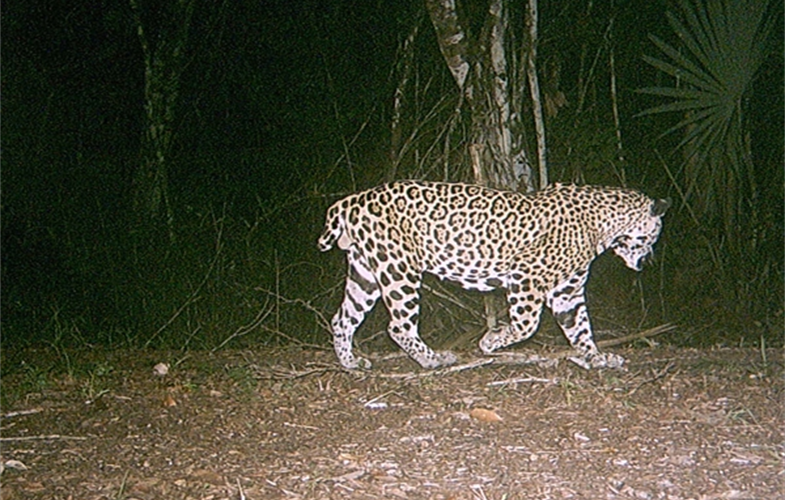- Scientists used remote cameras to photograph unusual jaguar in both Belize and Guatemala
- First known documentation of a jaguar crossing between these two countries
- Otherwise healthy jaguar is missing part of its tail from unknown injury
- Finding highlights the importance of securing critical forests on at-risk private properties at the Belize-Guatemala border
- Download copies of the study, additional images and figures
 CREDIT: Marcella Kelly
CREDIT: Marcella Kelly
PETÉN , GUATEMALA | JULY 07, 2020 - A team of WCS scientists have documented an unusual jaguar missing most of its tail crossing the border between Belize and Guatemala – the first confirmed transboundary crossing of a jaguar between the two countries. The team published their observation in a short communication in the journal CATnews – the newsletter of the Cat Specialist Group, a component of the Species Survival Commission SSC of the International Union for Conservation of Nature (IUCN).
The adult male jaguar was first photographed at Hill Bank in the Rio Bravo Conservation and Management Area in Belize in 2009. At that time, the cat had a complete and normal tail. When it was photographed again on 5 May 2011, and identified by its spot pattern, most of the tail was missing for unknown reasons. Then in Guatemala in 2013, the jaguar was recorded in camera trap surveys deployed in the community forest concessions of La Union and Rio Chanchich by WCS’s Rony García-Anleu and his field team. It appears that he then returned to Belize where he was last photographed in 2014.
But it wasn’t until 2018, at a workshop organized by the German Technical Cooperation (GIZ, Deutsche Gesellschaft für Internationale Zusammenarbeit GmbH) on monitoring of biodiversity and climate change in the tri-national Mexico-Guatemala-Belize Maya Forest, that researchers working in Belize and Guatemala realized that the same jaguar – now nicknamed “Short-Tail” – had been photo-captured in both countries.
Said the paper’s lead author, Rony García-Anleu of WCS’s Guatemala Program: “We were surprised and delighted when we saw that ‘Short-Tail’ was photographed by other researchers and was crossing the border between Guatemala and Belize. This highlights the importance and potential for collaborative work between Belize and Guatemala and across the Maya Forest region.”
WCS and partners are working to secure key parcels in Belize's portion of the Maya Forest – the Maya Forest Corridor and the Northwest properties of Yalbac and Laguna Seca. These lands are critical to the larger tri-national forest’s connectivity for jaguars and other wildlife.
Transboundary jaguars have been reported in other areas of the jaguar distribution range, including between Argentina and Brazil, and along Paraguay’s borders with both Bolivia and Brazil. In 2012–2013 researchers reported that two jaguars fitted with satellite global positioning system collars repeatedly crossed the Usumacinta River, a natural border shared by Guatemala and Mexico, at the far end of the same forest where short-tail was recorded.
Although transboundary jaguar movements are hard to observe since they take place in some of Latin America’s most remote forests, at least 26 of the most significant jaguar populations range wide are transboundary. Recognizing the importance of these areas, jaguars were listed in Appendices I and II of the Convention on Migratory Species (CMS) in February 2020, emphasizing the urgency of conservation in transboundary areas. Eleven jaguar range countries are signatories to CMS. In addition, to date 14 countries have endorsed the vision of the range-wide 2030 Jaguar Conservation Road Map, which also emphasizes transboundary conservation.
The Maya Forest is one of Mesoamerica's 5 Great Forests, spanning from Mexico to Colombia, collectively covering an area three times the size of Switzerland. The 5 Great Forests are all transboundary and represent Mesoamerica’s most critical bastions for jaguars and other wildlife, and provide services such as carbon sequestration, clean water, and food security to five million people. WCS is part of an alliance of countries, NGOs, Indigenous Peoples, and local communities committed to protecting these remaining areas.